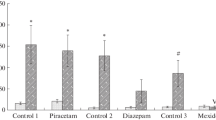Summary
The possible mechanisms of conditioned tolerance to the cataleptogenic effects of haloperidol and droperidol were studied in order to discriminate between “classical” and “conditioned” tolerance. Rats were conditioned by repeated administration (19–27 times) of haloperidol (1.5 mg/kg i. p.) or droperidol (1.5 mg/kg i. p.), respectively, in the presence of a sum of defined environmental (auditory, olfactory and tactile) stimuli. The animals were compared with pseudoconditioned rats, which underwent the same number of drug injections and exposures to the environmental stimuli, but neither were associated. In part of the experiments, one further group of rats was repeatedly treated with only solvent in the presence of the environmental stimuli. Rats conditioned with haloperidol or droperidol showed tolerance to the cataleptogenic effect of a test dose of haloperidol (1.5 mg/kg i. p.) or droperidol (1.5 mg/kg i.p.), respectively, when they were tested in presence of the defined conditioning stimuli. The rats conditioned with droperidol showed significantly less catalepsy than the pseudoconditioned animals 30 min after droperidol administration, whereas in rats conditioned with haloperidol, the catalepsy was less pronounced no sooner than 120 min after haloperidol administration. This was a manifestation of conditioned tolerance. In rats pseudoconditioned with droperidol, the catalepsy was similar to that produced by the drug in drug-naive rats, suggesting no classical tolerance due to repeated administration of the neuroleptic drug. The dopamine turnover in striatum or nucleus accumbens after administration of 1.5 mg/kg of haloperidol i.p. was not altered in rats conditioned with haloperidol when compared with pseudoconditioned animals. The stereotypies produced by apomorphine (0.16 mg/kg s. c.) were most pronounced in conditioned, less pronounced in pseudoconditioned and very small in drug-naive rats. These result suggest that the conditioned tolerance to the neuroleptic drugs is connected with an increased sensitivity of the basal ganglia to dopaminergic drugs. In another series of experiments, rats were conditioned with apomorphine 8 times and tested with 0.66 mg/kg of droperidol i.p. Rather unexpectedly, the catalepsy was significantly more pronounced in conditioned than in pseudoconditioned animals. This observation suggests that the type of conditioned effect, which becomes manifest, depends in part on the drug used in the presence of the conditioned stimuli.
Similar content being viewed by others
References
Andén N-E, Rubensson A, Fuxe K, Hökfelt T (1967) Evidence of dopamine receptor stimulation by apomorphine. J Pharm Pharmacol 19: 627–629
Asper A, Bagglioni M, Bürki HR, Lauener H, Ruch W, Stille G (1973) Tolerance phenomena with neuroleptics catalepsy, apomorphine stereotypies and striatal dopamine metabolism in the rat after single and repeated administration of loxapine and haloperidol. Eur J Pharmacol 22:287–294
Carlsson A (1975) Receptor-mediated control of dopamine metabolism. In: Usdin E, Bunney WE (eds)Pre- and postsynaptic receptors. Marcel Dekker Inc., New York, pp 49–53
Carlsson A, Lindquist M (1963) Effect of chlorpromazine or haloperidol on formation of 3-methoxytryptamine and normetanephrine in mouse brain. Acta Pharmacol Toxicol 20:140–144
Costall B, Naylor RJ (1974) On catalepsy and catatonia and the predictability of the catalepsy test for neuroleptic activity. Psychopharmacology 34:233–241
De Graaf C, Korf J (1986) Conditional tolerance to haloperidol-induced catalepsy is not caused by striatal dopamine receptor supersensitivity. Psychopharmacology 90:54–57
Eikelboom R, Stewart J (1982) Conditioning of drug-induced physiological responses. Psychol Rev 89:507–528
Ernst AM (1967) Mode of action of apomorphine and dexamphetamine in gnawing compulsion rats. Psychopharmacology 10:316–323
Havemann U, Magnus B, Möller H-G, Kuschinsky K (1986) Individual and morphological differences in the behavioural responses to apomorphine in rats. Psychopharmacology 90:40–48
Janssen PA, Niemegeers CJ, Schellekens KH (1965) Is it possible to predict the clinical effects of neuroleptic drugs (major transquillizers) from animal data? Arzneimittelforschung (Drug Res) 15:104–117
Ljungberg T, Ungerstedt U (1976) Automatic registrations of behaviour related to dopamine and noradrenaline transmission. Eur J Pharmacol 36:181–188
Mogilnicka E, Klimek V (1977) Drugs affecting dopamine neurons and yawning behaviour. Pharmacol Biochem Behav 7:303–307
Möller H-G, Kuschinsky K (1986) Interactions of morphine with apomorphine: behavioural and biochemical studies. Naunyn-Schmiedeberg's Arch Pharmacol 334:452–457
Möller H-G, Nowak K, Kuschinsky K (1987) Conditioning of pre-and postsynaptic behavioural responses to the dopamine receptor agonist apomorphine in rats. Psychopharmacology 91: 50–55
Nickolson VJ, van Riezen H, van Delft ML (1984) Response changes after repeated low apomorphine: dopamine autoreceptor desensitization or learning? Psychopharmacology 83:188–193
Poulos CX, Hinson R (1982) Pavlovian conditional tolerance to haloperidol catalepsy: evidence of dynamic adaptation in the dopaminergic system. Science 218:491–492
Puri SK, Lal H (1974) Tolerance to the behavioural and neurochemical effects of haloperidol and morphine in rats chronically treated with morphine or haloperidol. Naunyn-Schmiedeberg's Arch Pharmacol 282:155–170
Sanberg PR (1980) Haloperidol-induced catalepsy is mediated by postsynaptic dopamine receptors. Nature 284:472–473
Schiff SR (1982) Conditioned dopaminergic activity. Biol Psychiatry 17:135–154
Siegel S, Mac Rae J (1984) Environmental specificity of tolerance. Trends Neurosci 7:140–143
Tarsy D, Baldessarini RJ (1973) Pharmacologically induced behavioural supersensitivity to apomorphine. Nature New Biol 245:262–263
Author information
Authors and Affiliations
Additional information
Send offprint requests to K. Kuschinsky
Rights and permissions
About this article
Cite this article
Nowak, K., Welsch-Kunze, S. & Kuschinsky, K. Conditioned tolerance to haloperidol- and droperidol-induced catalepsy. Naunyn-Schmiedeberg's Arch Pharmacol 337, 385–391 (1988). https://doi.org/10.1007/BF00169528
Received:
Accepted:
Issue Date:
DOI: https://doi.org/10.1007/BF00169528




